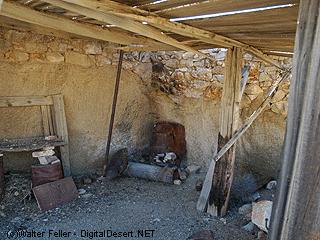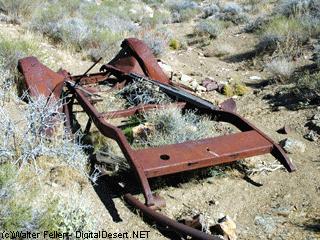Chloride Cliff
At this point our knowledge of the detailed activities at the Chloride Cliff become less perfect, as the Rhyolite Herald ceased publication. Still, even with the death of the Bullfrog District, Crowell hung on and worked the property by himself from time to time. In April of 1916 a small Lane mill was constructed on a group of claims just west of the abandoned site of Chloride City, but the mill operated only a few days, due to the shortage of water. A sixty-foot deep well which Crowell had dug about a mile from the new mill site went dry almost as soon as the mill was started. The mine and mill were listed as idle in 1917.
But Crowell still held on. Annual assessment work was done on the property through at least 1922, although Crowell was forced to sell a portion of his claims that year to satisfy some debts. In 1926 the mine was reported to be idle, and in 1928 it was sold to Louis McCrea of Beatty, who made several shipments of ore to a Salt Lake City smelter. The only recorded shipment during this time resulted in a profit of $47 per ton for thirty tons of ore. Between 1928 and 1931 several more shipments were made, but all were of small quantities, and in 1931 the property was being operated by the Chloride Cliff Mining & Milling Company, a new organization, which leased the mines from Louis McCrea. The new company, as usual, had grand plans to develop the mines and to pipe in water from twenty miles away, but as usual, nothing happened.
The mine, however, was still active in 1935, when six men were employed, who shipped 100 tons of ore in that year. At this time, all the mining work was being done on the surface, and it was reported, in an understatement, that the company needed "further equipment." In 1938, the California Journal of Mines and Geology reported that the mine, still owned by McCrea and his associates, had shipped about thirty tons per month between 1932 and 1936, before leasing the mine to the Coen Company who operated it from 1936 to 1937. After a few years of inactivity, McCrea was again reported to be shipping gold ore to a mill at Benton, California, in 1941.
During that same year, the Chloride Cliff area saw yet another mine make its appearance, when cinnabar was discovered a short distance northwest of the Chloride City site. The Crowell Mining and Milling Company undertook to develop this discovery, and erected a five-ton Cottrell mercury plant. But before more than an estimated 150 tons of ore could be processed, the small mercury plant caught fire and burned to the ground. The loss was too much for the company to absorb, and the cinnabar mine in turn was abandoned. This marked the last gasp of the Chloride Cliff area mines. Although intermittent prospecting and a few very small operations continued for several more years-forty-four claims were filed with the National Park Service between 1956 and 1960--no further significant activity took place.
< Previous
Next >

